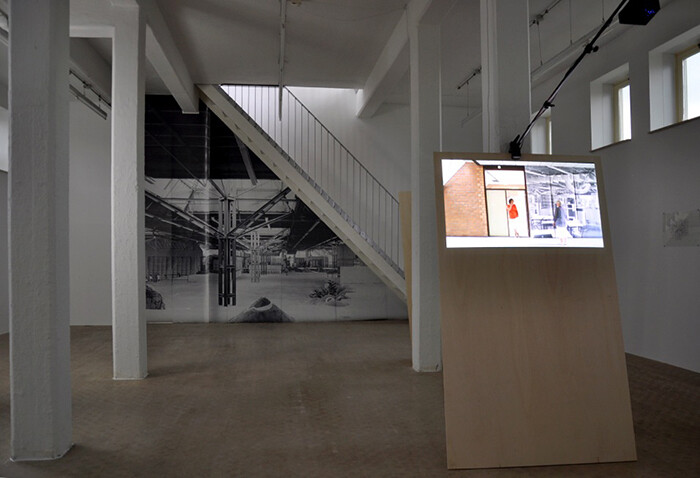The first week of October proved exceptional for Wendelien van Oldenborgh. As an awardee of the 2014 Heineken Prize for Art—the Netherlands’s wealthiest prize—the artist and filmmaker had swept through a schedule of lectures, media appearances, and finally a private audience with the Dutch monarch. For an artist best known for her incisive critiques of unspoken tensions—Dutch colonial legacies and the flaws in the nation’s armature of “tolerance,” for example—these were opportunities not to be missed. In a fitting homecoming, the week ended with a Sunday evening opening of an exhibition of new work in Rotterdam, the artist’s hometown.
“Footnotes to Beauty and the Right to the Ugly,” at Wilfried Lentz, is a collection of filmic and documentary materials continuing van Oldenborgh’s research into Dutch social infrastructures, yet one that perhaps marks a new spatial turn in her practice. Elements of a film fill the gallery space: videos on self-supporting projection units, a wallpaper, and architectural diagrams. In these fragmented components, viewers encounter the debris of the 1970s Dutch ideals of maakbaarheid [social engineering] and an “open society” amid the Foucauldian double-bind of a utopic reinvestment in life against the commoditized reality of lifestyle.
In the tradition of cinéma vérité, van Oldenborgh has been developing over the past decade a filmic methodology in which she builds well-honed social machines to interrogate political incommensurabilities. In order to do so she combines invested protagonists, archival texts, and expressive devices such as musical instruments, which are staged in deeply coded holding environments. This strategy is typified in the 2006 project Maurits Script, which revisited the much overlooked Dutch colonial occupation of Recife, Brazil, under governor Johan Maurits van Nassau-Siegen amid the opulent eponymous Mauritshuis museum in The Hague. Pressing play on these socio-political assemblages, van Oldenborgh sets out to capture—on film and video—the acute symptoms of submerged conflict as dialogue and events unfold.
Het Karregat, an “open architecture” project built in Eindhoven in 1974, is the central subject of “Footnotes to Beauty and the Right to the Ugly.” Blurring work, family, and social life, the complex housed a library, school, health center, supermarket, and communal area without physical partitions. As revealed in a blueprint of the building—transposed, in the exhibition, with Van Oldenborgh’s own filming schedule in Floorplans of Het Karregat (all works 2014)—the open-plan structure was cemented in with awkward cellular enclaves after a renovation in the 1990s. Wall Print, a wallpaper vista of the original school, offers spatial memory of the site as xeroxed echo.
The exhibition’s “Footnotes”—Footnote to Chapter 1, 2, and 3—consist of three installations comprising short videos towards longer pieces in development for an exhibition at Eindhoven’s Van Abbe Museum later this year. In the videos, original and current inhabitants of Het Karregat appear surrounded by both the original building’s industrial high ceilings and the institutional brick walls of its later renovation. The conflict between these architectural layers issues forth the work’s underlying theme: the drama of the late 1970s and early ’80s transition from a society of discipline to one of control.
A “generalized crisis” exists in this transition, as Gilles Deleuze noted in a 1992 essay in October.1 Deleuze argued that despite social bids for emancipation from the eighteenth- and nineteenth-century disciplinary enclosures of the hospital, school, barracks, and prison, these structures instead disarticulated into modular flows of decentralized power. In the Netherlands, these emancipatory ideals stemmed from venerable and antagonistic sources, such as the Situationist International, with Constant Nieuwenhuys’s imagined circulatory and radial anti-capitalist city of New Babylon. A governmental form for such aspirations was even established in the Social and Cultural Planning Office under prime minister Joop Den Uyl (1973–77), which was delegated to implement a direct democracy of social feedback. Yet the ideal of self-determined space embodied in Het Karregat all too quickly became subsumed as “creativity,” was recast as “research and development,” and finally was outsourced onto the adaptive behaviors of the citizen as client.
A bulldozer bursting unceremoniously through a wall in the video Footnote 1: Open Architecture for Open Society perfectly portrays the brute power of bricks and mortar pulverized into a fine, pervasive haze. Across the three video “footnotes,” this rupturing emerges as a generational schism: the grey-ponytailed Hans riffs on his fond memories of “the experiment” with percussion instruments, while the younger low-rent-paying tenant Maaike writes a love poem to the walls, opining the protection she feels in their strong, if austere, embrace.
These candid expressions are a hallmark of van Oldenborgh’s work. They divulge arresting truths of a social conflict such as the shifts surrounding Het Karregat. It is through van Oldenborgh’s scrupulous attention to her own authorship and to the politics of the documentary gaze that such transmission is possible. This is a quality that sets her apart from other Dutch artists currently wrestling with sociopolitical complexities. “Footnotes to Beauty and the Right to the Ugly” underscores a well-deserved award-winner with a body of work pointing not to a conclusion but to a renewed investment in form.
Gilles Deleuze, “Postscript on the Societies of Control,” October 59 (1992): 3–7.










